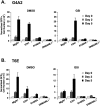Notch dimerization is required for leukemogenesis and T-cell development
- PMID: 20935071
- PMCID: PMC2964750
- DOI: 10.1101/gad.1975210
Notch dimerization is required for leukemogenesis and T-cell development
Abstract
Notch signaling regulates myriad cellular functions by activating transcription, yet how Notch selectively activates different transcriptional targets is poorly understood. The core Notch transcriptional activation complex can bind DNA as a monomer, but it can also dimerize on DNA-binding sites that are properly oriented and spaced. However, the significance of Notch dimerization is unknown. Here, we show that dimeric Notch transcriptional complexes are required for T-cell maturation and leukemic transformation but are dispensable for T-cell fate specification from a multipotential precursor. The varying requirements for Notch dimerization result from the differential sensitivity of specific Notch target genes. In particular, c-Myc and pre-T-cell antigen receptor α (Ptcra) are dimerization-dependent targets, whereas Hey1 and CD25 are not. These findings identify functionally important differences in the responsiveness among Notch target genes attributable to the formation of higher-order complexes. Consequently, it may be possible to develop a new class of Notch inhibitors that selectively block outcomes that depend on Notch dimerization (e.g., leukemogenesis).
Figures







Similar articles
-
Long-range enhancer activity determines Myc sensitivity to Notch inhibitors in T cell leukemia.Proc Natl Acad Sci U S A. 2014 Nov 18;111(46):E4946-53. doi: 10.1073/pnas.1407079111. Epub 2014 Nov 4. Proc Natl Acad Sci U S A. 2014. PMID: 25369933 Free PMC article.
-
Notch signaling expands a pre-malignant pool of T-cell acute lymphoblastic leukemia clones without affecting leukemia-propagating cell frequency.Leukemia. 2012 Sep;26(9):2069-78. doi: 10.1038/leu.2012.116. Epub 2012 Apr 27. Leukemia. 2012. PMID: 22538478 Free PMC article.
-
DDX5 is a positive regulator of oncogenic NOTCH1 signaling in T cell acute lymphoblastic leukemia.Oncogene. 2013 Oct;32(40):4845-53. doi: 10.1038/onc.2012.482. Epub 2012 Oct 29. Oncogene. 2013. PMID: 23108395 Free PMC article.
-
The NOTCH1-MYC highway toward T-cell acute lymphoblastic leukemia.Blood. 2017 Mar 2;129(9):1124-1133. doi: 10.1182/blood-2016-09-692582. Epub 2017 Jan 23. Blood. 2017. PMID: 28115368 Review.
-
Notch in Leukemia.Adv Exp Med Biol. 2018;1066:355-394. doi: 10.1007/978-3-319-89512-3_18. Adv Exp Med Biol. 2018. PMID: 30030836 Review.
Cited by
-
Enhancers with cooperative Notch binding sites are more resistant to regulation by the Hairless co-repressor.PLoS Genet. 2021 Sep 24;17(9):e1009039. doi: 10.1371/journal.pgen.1009039. eCollection 2021 Sep. PLoS Genet. 2021. PMID: 34559800 Free PMC article.
-
Structural and mechanistic insights into cooperative assembly of dimeric Notch transcription complexes.Nat Struct Mol Biol. 2010 Nov;17(11):1312-7. doi: 10.1038/nsmb.1938. Epub 2010 Oct 24. Nat Struct Mol Biol. 2010. PMID: 20972443 Free PMC article.
-
Notch dimerization and gene dosage are important for normal heart development, intestinal stem cell maintenance, and splenic marginal zone B-cell homeostasis during mite infestation.PLoS Biol. 2020 Oct 5;18(10):e3000850. doi: 10.1371/journal.pbio.3000850. eCollection 2020 Oct. PLoS Biol. 2020. PMID: 33017398 Free PMC article.
-
DEPTOR is a direct NOTCH1 target that promotes cell proliferation and survival in T-cell leukemia.Oncogene. 2017 Feb 23;36(8):1038-1047. doi: 10.1038/onc.2016.275. Epub 2016 Sep 5. Oncogene. 2017. PMID: 27593934
-
MYC in T-cell acute lymphoblastic leukemia: functional implications and targeted strategies.Blood Sci. 2021 Jun 7;3(3):65-70. doi: 10.1097/BS9.0000000000000073. eCollection 2021 Jul. Blood Sci. 2021. PMID: 35402840 Free PMC article. Review.
References
-
- Aifantis I, Mandal M, Sawai K, Ferrando A, Vilimas T 2006. Regulation of T-cell progenitor survival and cell-cycle entry by the pre-T-cell receptor. Immunol Rev 209: 159–169 - PubMed
-
- Artavanis-Tsakonas S, Rand MD, Lake RJ 1999. Notch signaling: Cell fate control and signal integration in development. Science 284: 770–776 - PubMed
Publication types
MeSH terms
Substances
Grants and funding
- R01 AI047833/AI/NIAID NIH HHS/United States
- T32 DK007780/DK/NIDDK NIH HHS/United States
- P01CA119070/CA/NCI NIH HHS/United States
- R01AG02666/AG/NIA NIH HHS/United States
- R01 CA092433/CA/NCI NIH HHS/United States
- T32 CA009140/CA/NCI NIH HHS/United States
- T32-CA009140/CA/NCI NIH HHS/United States
- K08 CA120544-01/CA/NCI NIH HHS/United States
- RC1 HL099758/HL/NHLBI NIH HHS/United States
- RC1HL099758/HL/NHLBI NIH HHS/United States
- K08 CA120544/CA/NCI NIH HHS/United States
- P01 CA119070/CA/NCI NIH HHS/United States
- R01AI047833/AI/NIAID NIH HHS/United States
- T32-DK07780/DK/NIDDK NIH HHS/United States
LinkOut - more resources
Full Text Sources
Other Literature Sources
